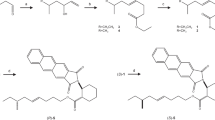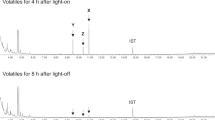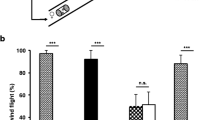Abstract
A female-produced sex pheromone of Stylops muelleri was identified as an unusually branched saturated aldehyde (9R)-3,5-syn-3,5,9-trimethyldodecanal. We named it stylopsal. Its structure was established by using mass spectrometry, infrared spectroscopy, and organic synthesis of candidate compounds. The synthetic standard of (9R)-3,5-syn-3,5,9-trimethyldodecanal gave identical chromatographic and mass spectrometric data as the natural pheromone and also was active in electroantennographic and behavioral assays. The female fat body lipids contained the corresponding fatty acid, indicating a possible link between lipid metabolism and the pheromone biosynthesis.




Similar content being viewed by others
References
Bates, D. and Maechler, M. 2010. Lme4: Linear mixed-effects models using S4 classes. R package version 0.999375-34. URL:http://CRAN.R-project.org/package=lme4
Beutel, R. G., Friedrich, F., Hornschemeyer, T., Pohl, H., Hunefeld, F., Beckmann, F., Meier, R., Misof, B., and Whiting, M. F. 2011. Morphological and molecular evidence converge upon a robust phylogeny of the megadiverse Holometabola. Cladistics 27:341–355.
Brandenburg, J. 1953. Der Parasitismus der Gattung Stylops an der Sandbiene Andrena vaga Pz. Z. Parasitenkd. 15:457–475.
Cheng, C. and Gross, M. L. 2000. Applications and mechanisms of charge-remote fragmentation. Mass Spectrom. Rev. 19:398–420.
Chow, S., Fletcher, M. T., Lambert, L. K., Gallagher, O. P., Moore, C. J., Cribb, B. W., Allsopp, P. G., and Kitching, W. 2005. Novel cuticular hydrocarbons from the cane beetle Antitrogus parvulus - 4,6,8,10,16-penta- and 4,6,8,10,16,18-hexamethyldocosanes - Unprecedented anti-anti-anti-stereochemistry in the 4,6,8,10-Methyl Tetrad. J. Org. Chem. 70:1808–1827.
Cvačka, J., Kofroňová, E., Vašíčková, S., and Stránský, K. 2008. Unusual fatty acids in the fat body of the early nesting bumblebee, Bombus pratorum. Lipids 43:441–450.
Dallai, R., Lupetti, P., Giusti, F., Mercati, D., Paccagnini, E., and Turillazzi, S. 2004. Fine structure of the Nassonow’s gland in the neotenic endoparasitic of female Xenos vesparum (Rossi) (Strepsiptera, Insecta). Tissue Cell 36:211–220.
De Mico, A., Margarita, R., Parlanti, L., Vescovi, A., and Piancatelli, G. 1997. A versatile and highly selective hypervalent iodine (III)/2,2,6,6-tetramethyl-1-piperidinyloxyl-mediated oxidation of alcohols to carbonyl compounds. J. Org. Chem. 62:6974–6977.
Dewick, P. M. 2009. pp. 39–135, Medicinal natural products. A biosynthetic approach, Third ed.. Wiley, Chichester.
Friedrich, F. and Beutel, R. G. 2010. Good bye Halteria? The evolution of the thorax in Holometabola. Cladistics 26:579–612.
Harvey, D. J. 1991. Pyridine-containing schiff base derivatives for the structural determination of long-chain aldehydes by gas chromatography combined with mass spectrometry. J. Am. Soc. Mass Spectrom. 2:245–249.
Hughes, D. P., Kathirithamby, J., Turillazzi, S., and Beani, L. 2004. Social wasps desert the colony and aggregate outside if parasitized: Parasite manipulation? Behav. Ecol. 15:1037–1043.
Ishiwata, K., Sasaki, G., Ogawa, J., Miyata, T., and Su, Z.-H. 2011. Phylogenetic relationships among insect orders based on three nuclear protein-coding gene sequences. Mol. Phylogenet. Evol. 58:169–180.
Katritzky, A. R., Chen, K., Maran, U., and Carlson, D. A. 2000. QSPR correlation and predictions of GC retention indexes for methyl-branched hydrocarbons produced by insects. Anal. Chem. 72:101–109.
Kinzelbach, R. 1971. Morphologische Befunde an Fächerflüglern und ihre phylogenetische Bedeutung (Insecta: Strepsiptera). Zoologica 41 Schweizerbart’sche Verlagsbuchhandlung, Stuttgart, 256 p.
Knierzinger, A., Walther, W., Weber, B., Mueller, R. K., and Netscher, T. 1990. A new method for the stereochemical analysis of acyclic terpenoid carbonyl compounds. Helv. Chim. Acta 73:1087–1107.
Linsley, E. G. and MacSwain, J. W. 1957. Observations on the habits of Stylops pacifica Bohart. Univ. Calif. Publ. Entomol. 11:395–430.
Longhorn, S. J., Pohl, H. W., and Vogler, A. P. 2010. Ribosomal protein genes of holometabolan insects reject the Halteria, instead revealing a close affinity of Strepsiptera with Coleoptera. Mol. Phylogenet. Evol. 55:846–859.
Lopez, F., Harutyunyan, S. R., Meetsma, A., Minnaard, A. J., and Feringa, B. L. 2005. Copper-catalyzed enantioselective conjugate addition of grignard reagents to α,β-unsaturated esters. Angew. Chem. Int. Ed. 44:2752–2756.
McKenna, D. D. and Farrell, B. D. 2011. 9-Genes reinforce the phylogeny of Holometabola and yield alternate views on the phylogenetic placement of Strepsiptera. PLoS One 5:e11887.
R Development Core Team 2010. R: A language and environment for statistical computing. R Foundation for Statistical Computing, Vienna, Austria. ISBN 3-900051-07-0. URL http://www.R-project.org.
Riek, E. F. 1970. Strepsiptera, pp. 622–635, in E. B. Britton et al. (eds.), The Insects of Australia. Melbourne University Press, Australia.
Růžička, Z. 1987. Fine structure of some external organs in Xenos vesparum (Strepsiptera, Sytopidae). Acta Entomol. Bohemoslov. 84:438–440.
Salt, G. 1927. The effects of stylopization on aculeate Hymenoptera. J. Exp. Zool. 48:223–331.
Steinebrunner, F., Schiestl, F. P., and Leuchtmann, A. 2008. Variation of insect attracting odor in endophytic Epichloë fungi: Phylogenetic constrains versus host influence. J. Chem. Ecol. 34:772–782.
Straka, J., Rezková, K., Batelka, J., and Kratochvíl, L. 2011. Early nest emergence of females parasitised by Strepsiptera in protandrous bees (Hymenoptera Andrenidae). Ethol. Ecol. Evol. 23:97–109.
Stránský, K. and Jursík, T. 1996. Simple quantitative transesterification of lipids. 1. Introduction. Fett/Lipid 98:65–71.
Tang, L. and Deng, L. 2002. Dynamic kinetic resolution via dual-function catalysis of modified cinchona alkaloids: Asymmetric synthesis of α-hydroxy carboxylic acids. J. Am. Chem. Soc. 124:2870–2871.
Wang, Y. and Metz, P. 2000. Resolution of methyl nonactate. Tetrahedron: Asymmetry 11:3995–3999.
Weitzel, G. and Wojahn, J. 1951. Biochemie verzweigter Carbonsäuren. V. Mitteilung. Darstellung sämtlicher d,l-Monomethyl-palmitinsäuren. Hoppe Seylers Z. Physiol. Chem. 287:65–88.
Whiting, M. F., Carpenter, J. C., Wheeler, W. C., and Wheeler, Q. D. 1997. The Strepsiptera problem: phylogeny of the holometabolous insect orders inferred from 18 s and 28 s ribosomal DNA sequences and morphology. Syst. Biol. 46:1–68.
Acknowledgements
This research was funded by the Czech Science Foundation (Project No. P506/10/1466) and the Academy of Sciences of the Czech Republic (Project RVO: 61388963). The authors wish to thank all colleagues and students involved in digging parasitized bees, to Martin Weisser for helping us with statistical analyses, to Pavel Krásenský for pictures, and Mr. Sean Mark Miller for proofreading the manuscript and making corrections.
Author information
Authors and Affiliations
Corresponding author
Additional information
This and the following paper by Tolasch et al., are being published in tandem. The research was presented to the scientific community and submitted to the Journal within a short timeframe, and the work reported is similar and complementary. All authors agreed to the decision of the Editors
Electronic supplementary material
Rights and permissions
About this article
Cite this article
Cvačka, J., Jiroš, P., Kalinová, B. et al. Stylopsal: The First Identified Female-produced Sex Pheromone of Strepsiptera. J Chem Ecol 38, 1483–1491 (2012). https://doi.org/10.1007/s10886-012-0214-7
Received:
Revised:
Accepted:
Published:
Issue Date:
DOI: https://doi.org/10.1007/s10886-012-0214-7




